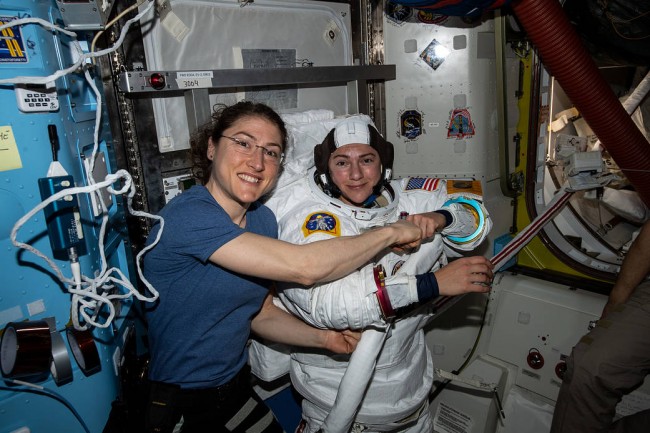One Small Step for Women, One Giant Leap for Womankind.
Christina Koch and Jessica Meir prepare for their first All Women Space Walk fro NASA.
October 31, 2019
On Oct. 18, 2019, the National Aeronautics and Space Administration (NASA) made history by executing the first all-woman space walk. Astronauts Christina Koch and Jessica Meir have spent several years training with the NASA academy to prepare for this remarkable mission. With an increase of women in technological industries, this spacewalk marks a substantial growth of women representation in the STEM fields, and serves as an inspiration for many more female astronauts to come.
“Having an all-woman space walk shows how far we have come as women in a society still dominated by men. It makes me proud to witness these woman and gives me motivation to follow my dreams,” said senior Tanmayee Kolli.
For Meir and Koch, their journey leading up to the spacewalk is as inspiring as the event itself. Both astronauts had to go through extensive preparation in NASA’s training program, and coincidentally trained together in NASA’s 2013 class of astronaut trainees. In the process of aeronautical training, all astronauts are held to the same standard regardless of sex. Each trainee is chosen based upon physical and mental strength, both important factors when spending months or years in space.
Meir and Koch’s spacewalk lasted about seven hours, marking history. The event began at 7:38 a.m. EDT as Koch and Meir switched to battery power in their spacesuits, with the guidance of Stephanie Wilson to lead the capsule. Their task was to replace a battery charge/discharge unit that had failed to activate. Although the labor required for spacewalking itself takes a physical toll on their body, the women handled the situation smoothly and successfully replaced the batteries near the International Space Station.
“I think it would be amazing for NASA to push for more women in aeronautics and space science industry because it sets a great example for current grade school girls who are indecisive about what career fields they should explore,” said senior Tanya Charan, president for Girls Who Code. “Putting more women in space would also help diversify the input we get in the realm of scientific thought.”
These daring women have defied all odds, from social criticism to overcoming gender inequality, serving as inspiration for many aspiring to join the aeronautical field. Women make up about a third of NASA’s workforce, and this number continues to grow as NASA and many different technological and male-dominated industries open up to the concept of hiring women to create a more inclusive and diverse work environment. This historical event has not only changed the lives of people, but science itself, proving that innovation and growth is the key to moving forward in today’s society. The impact of this event will pave the path for more women to travel to the moon and even Mars. Who knows, maybe you will be creating history someday.























